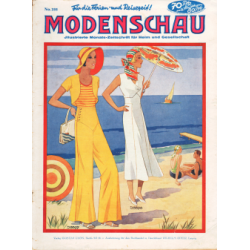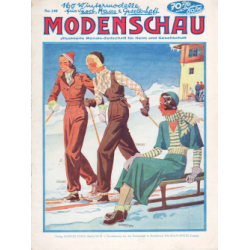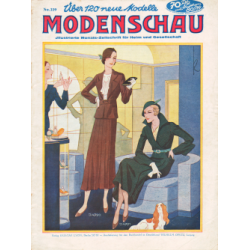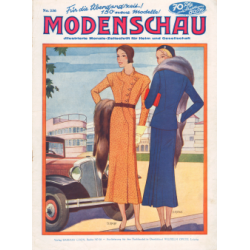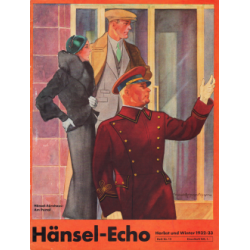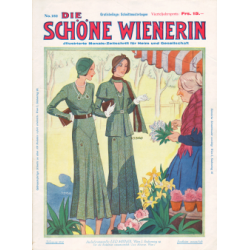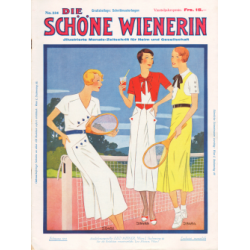Fashion 1932
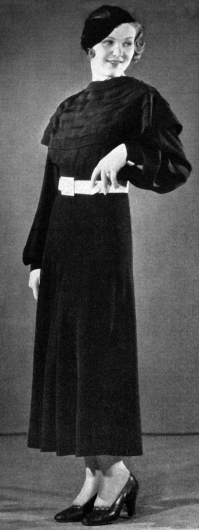 Simple day-end dress in black crepe Bamboula demonstrated by Grit Lagerquist. Fabric panels make the cape collar — Elegante Welt, no. 19 (21), September 12, 1932, p. 4. Photo: Binder
Simple day-end dress in black crepe Bamboula demonstrated by Grit Lagerquist. Fabric panels make the cape collar — Elegante Welt, no. 19 (21), September 12, 1932, p. 4. Photo: Binder
 Afternoon dresses. High, tight waist and special emphasis on sleeves are fashionable
—
Modenschau Issue #235, July 1932, p. 28a
Afternoon dresses. High, tight waist and special emphasis on sleeves are fashionable
—
Modenschau Issue #235, July 1932, p. 28a
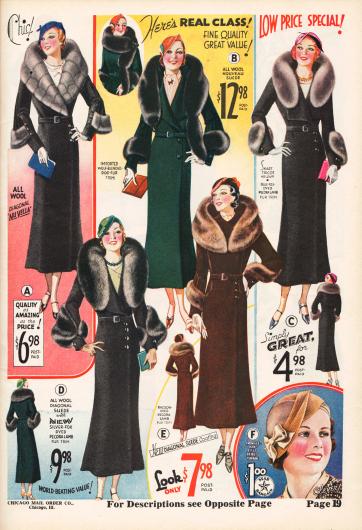 Lavish fur trim on collars and sleeves are now affordable only for a few
—
Chicago Mail Order Co. Fall/Winter 1932, p. 19
Lavish fur trim on collars and sleeves are now affordable only for a few
—
Chicago Mail Order Co. Fall/Winter 1932, p. 19
 Casual pajama fashion for the beach and a two-piece "air swimsuit" top left
—
Modenschau Issue #235, July 1932, p. 24b
Casual pajama fashion for the beach and a two-piece "air swimsuit" top left
—
Modenschau Issue #235, July 1932, p. 24b
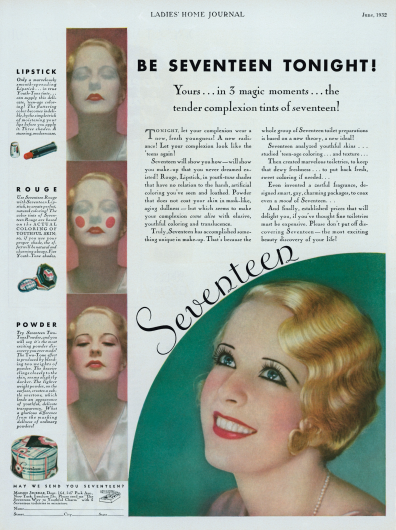 "Be Seventeen Tonight!" Advertisement for preparations by Seventeen. Color photograph — Ladies Home Journal, no. 6 (49), June 1932, p. 90
"Be Seventeen Tonight!" Advertisement for preparations by Seventeen. Color photograph — Ladies Home Journal, no. 6 (49), June 1932, p. 90
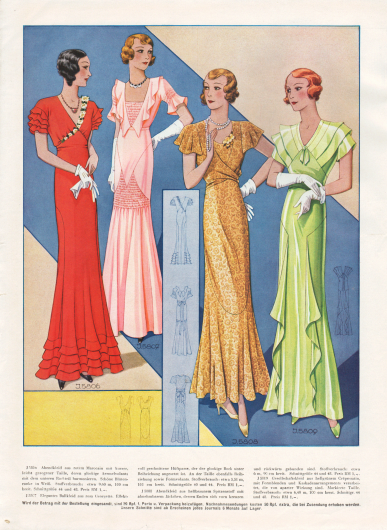 Evening and ball gowns for grand parties made of red marocain, pink Georgette, light brown lace fabric and light green crepe satin
—
Modenschau Issue #236, August 1932, p. 26d
Evening and ball gowns for grand parties made of red marocain, pink Georgette, light brown lace fabric and light green crepe satin
—
Modenschau Issue #236, August 1932, p. 26d
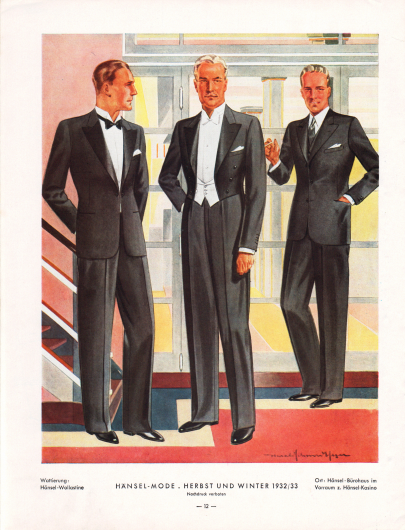 Elegant evening dress for men. Tuxedo, tailcoat and an elegant dark suit. Drawing: Harald Schwerdtfeger (1888-1956)
—
Hänsel-Echo Issue #12, 0 1932, p. 12
Elegant evening dress for men. Tuxedo, tailcoat and an elegant dark suit. Drawing: Harald Schwerdtfeger (1888-1956)
—
Hänsel-Echo Issue #12, 0 1932, p. 12
With the peak of the world economic crisis in 1932, fashion issues fade into the background, but the fashion trend does not stop there. High unemployment in Europe and North America and falling incomes force people to think about existential questions rather than the latest Parisian chic.
Despite strong deflation and the resulting drastic drop in prices, only a few can afford to make new purchases for the new season. High unemployment - in the German Reich alone, almost 6 million people were out of work in 1932 - and falling wages force people to re-sew and mend their old clothes.
Unemployment in the USA also reaches its peak with 12 million individuals without work. Thus the American mail-order company Sears states in its fall and winter catalog 1932/33:
"These are not ordinary times […]. Of greatest importance today are the costs of the necessities of life. We have realized that. […] We realize the struggle that is taking place everywhere to make ends meet."1
Hollywood Gains Influence
The dream factory Hollywood offers a change to the difficult everyday life, which brings glamour and glamour into the sorrowful depression time with its films. Stars like Marlene Dietrich, Greta Garbo or Joan Crawford embody the ideal of the time. Film actresses are therefore often chosen as beautiful figureheads for advertisements in fashion magazines and journals to promote beauty products and make-up. Mail-order catalogues are now also increasingly using Hollywood stars to advertise for the female clientele. For example, the Chicago Mail Order mail-order company advertised in the Fall Winter catalog 1932/33 with stars like Lila Lee, Claudia Dell and Sidney Fox.
Pajamas for Leisure Time Chic
Last year's casual beach pajamas are still very popular this year. It is not only popular for the beach or the promenade or the health resort, sometimes this light dress is also seen in the city, as not least the airy wide sailing pants and the short-sleeved blouse give the wearer a certain light-heartedness and ease. Summer dresses are made of wool jersey, marocaine, romaine, wool lace, mesh and piqué fabrics.
Swimwear 1932
The swimwear 1932 is characterized by vibrant, lively colours and modern abstract patterns. Women's swimsuits are one-piece, consisting of a short panty and a skin-tight jersey with generous cut-outs for arms and neck. The back neckline is usually so deep that the Reich Commissioner of the Prussian Minister of the Interior Dr. Bracht, under pressure from conservative groups, feels compelled to issue the so-called "Zwickelerlass" or gusset decree in August, which also applies to men's swimsuits. The gusset decree forbids the ladies to have necklines at the belly and waist and requires that the back neckline does not extend beyond the end of the shoulder blades.
Swimsuits for men are very similar to swimsuits for women, although swim trunks for men are already popular, but are no longer permitted for every bathing resort.
Long Skirts and Puffed Sleeves
Skirt hems reach their lowest level this year; they end just below the calf for day dresses, while the hems for formal afternoon and tea dresses are almost ankle-length. Evening dresses are floor-length. The waist is high and tight, making the upper body appear short and narrow. So there is a special emphasis on the sleeves and a wide shoulder close to the upper body. Already last year many designers have provided coat sleeves with fur trimmings or dress sleeves with lapels. This year, many fashion designers are turning their attention to sleeves with the greatest dedication. High or rather low puffed sleeves of any colour with or without cuffs, elastic bands for high puffing up the sleeves, medieval-looking club sleeves that become skintight on the forearm, overlapping trimmings at the shoulder/sleeve transition or cut flaps are evidence of creative imagination and craftsmanship.
The small velour and felt hats, which are worn very deep into one side of the face, have become generally accepted. Especially popular this year are small bows as garnish for the hat.
Covered Back for Evening Dresses
The biggest change in evening wear for the lady this year is captured by the Ladies Home Journal in its April issue in the article "backs are covered these spring evenings."2 The restrained covering is also accompanied in the elegant evening gown by a special shoulder emphasis on the dresses. Although most evening dresses are exclusively sleeveless, some dresses are enriched with short puff sleeves or wide cape sleeves. Boleros or short jackets take over puffed sleeves in place of sleeveless evening dresses. Pumps with very high pointed heels are an integral part of elegant evening attire.
Modern Jacket Suits for the Day
The modern single-breasted jacket suit shows "a light fullness of fabric. The shoulders are straight, rounded at the base of the sleeves and supported by a light cotton wool pad at the armpit. The armhole seams are straight and the waist is accentuated by a bust darts. The flaps are straight on the outer edge and in the flap break, slightly narrower and roll over briefly."3
"The double-breasted jacket has the same lines as the single-breasted jacket. [...] The double-breasted jacket is closed with two buttons, a third button is blind. The uppermost button is placed exactly in the normal waist line"4 and single-breasted vests are worn. Young, slender figures can also wear double-breasted vests. The trousers are cut long "and not too wide at the thighs."5
In the United States, suits for college-age young men with angular shoulder/sleeve transitions and trousers with over 22-inch wide legs and a very wide belt band are becoming fashionable. The pronounced wide shoulders and slim, tight waist give the college suits their characteristic line.
Evening Wear for Men
For the elegant gentleman, the tailcoat, sometimes even with the matching top hat for the evening, is "almost indispensable and the tuxedo is only ever a makeshift"6, as Bruno Henschke states in the spring issue of the German company magazine Haensel-Echo. "The tuxedo has the form of a single-breasted jacket. It closes with a button, this one stands in normal waist height and is buttoned up properly."7
Fashion for men has seemingly hardly changed in recent years. The changes can be perceived rather in detail: Lapel width and lapel base, with or without an additional blind buttonhole, sleeve base, pockets and the type of cut show slight changes from season to season. The Haensel Echo summarizes the general fashion line for men in this way: "high chest, strong shoulders, slim waist and hips."8
Mode aus Katalogen und Zeitschriften des Jahres 1932
Footnotes
1 Sears, Roebuck & Co., catalog no. 165, Chicago, Fall/Winter 1932-33, first inside cover.
2 N. N., Backs are Covered These Spring Evenings, in: Ladies' Home Journal, no. 4 (49), April 1932, p. 36.
3 Henschke, Bruno, Winke für die Fruehjahrs- und Sommermode 1932. Den Haensel-Freunden fuer die Praxis, in: Haensel-Echo, no. 11 (6), Spring and Summer 1932, p. 3-5, here p. 3.
4 Ibid., p. 4.
5 Ibid.
6 Ibid.
7 Ibid.
8 Ibid., p. 3.




